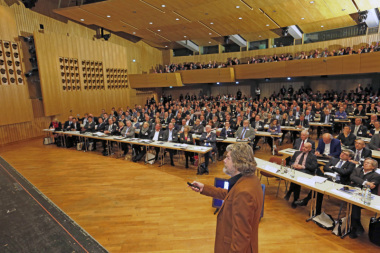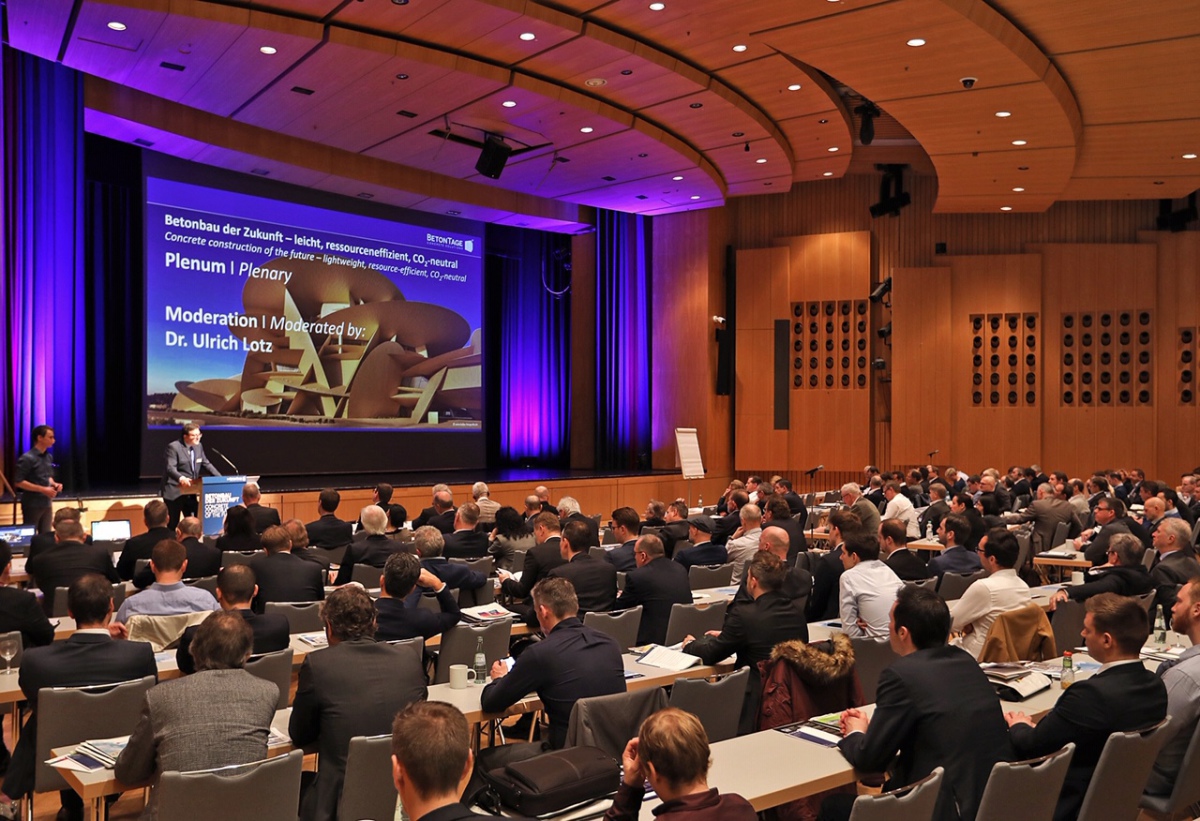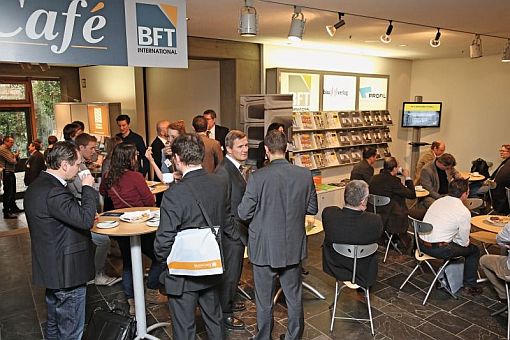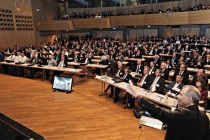Know-how for the high-tech material of the 21st century
Those who want to “build the future” today need state-of-the-art knowledge and expertise. To this end, the BetonTage congress has been offering specific support for many years. From 10 to 12 February 2009, Europe’s leading congress of the precast concrete industry will be held at the Edwin-Scharff-Haus in Neu-Ulm already for the 53rd time to provide information about most recent developments in concrete technology and precast construction. In plenary sessions and product-specific panels, technical, commercial and legal aspects will be presented and discussed, and trends and prospects for the future outlined. Simultaneous interpretation into English will be provided for selected plenary sessions and panels. Once again, over 2,000 attendees both from Germany and abroad are expected to register. As a lead-in to the program of this high-profile congress, the following sections introduce key topics to be discussed at the event.
Germany in 2030
At this congress, the keynote speech will be delivered by the renowned trend researcher Prof. Dr. Horst W. Opaschowski, of the BAT Foundation for Future Research in Hamburg. How will our world have changed by 2030? How will we live and work in the future? In his presentation, he will highlight future trends expected not only in society, economy and politics but also in culture, recreation and everyday life. He will use logical forecasts to outline the way into the future.
Developments in concrete technology
Sustainability, strength, durability – these are the key concepts that will influence construction in the future. Concrete as a building material is well-prepared to take on these challenges. Panel 1, Application-oriented Research for Concrete, will report on the findings of research undertaken for high-performance concretes and their successful implementation, and will also present projects currently being worked on at German and international universities.
Other examples of successful ways From Research into Practice will be described in Panel 5, including the use of special cement to implement a practically feasible production process for UHPC that eliminates the need for silica dust, or the use of concrete additives to produce ultra-high performance concretes. A precast manufacturer will provide useful insights relevant to practical application by reporting on the experience gained in the design and production of high-performance concretes at the factory, such as self-compacting concrete, and of a non-fines lightweight concrete.
Solutions for structural engineering
Panel 3, Structural Precast Construction, will be opened with an example of a successful international cooperation – a precast bridge consisting of fiber-reinforced, ultra-high performance concrete will be presented. The bridge was designed and engineered in Austria while production and quality assurance took place in Germany. The cost efficiency and flexibility of precast concrete elements is demonstrated by two new developments of reinforced floor slabs and prestressed concrete element floors. The panel will be rounded off by contributions dealing with the on-site assembly and CE and Ü (i.e. German conformity) marking of structural precast products. A new lattice girder system and fasteners will be presented in Panel 6, Concrete Products with Lattice Girders. The contributions will concentrate on cost-benefit analyses and product quality, which are key factors ensuring the products’ competitiveness. This panel will also deal with the CE marking of element slabs, provide practical recommendations for load securing, and present the results of a recent investigation into the assembly condition of element slabs. Panel 7 will focus on the potentials of Lightweight Concrete construction, including contributions with respect to processing technology, workability, and physical performance in terms of soundproofing and heat insulation. The presentation of the “Environmental Declaration for Lightweight Concrete in a National and European Context” will underscore the sustainable nature of this material.
Innovations for civil engineering Panel 2, Road Construction, Landscaping and Gardening, will first report on the current status of the new SLG communication concept entitled “precast stone – natural but better”. In the following part, experts will discuss issues related to relevant construction methods, dealing with plant and equipment as well as with the production and laying of concrete pavers. The panel will also refer to currently applicable standards and regulations governing concrete pavers, curbs and slabs.
Panel 11, Concrete and Reinforced Concrete Pipes, will address manufacturers, planners and public sector representatives. The panel will be opened by a presentation entitled “The Sewage Experience – A Brief Cultural History of Water Engineering”. The following contributions will refer to innovations such as acid-resistant concrete, coating materials and quality assurance and control methods that demonstrate the potential offered by sustainable pipeline construction using concrete pipes. The range of civil engineering topics will be complemented by Panel 12, Small Wastewater Treatment Plants. Once again, a technical program has been prepared for manufacturers and representatives of local water authorities, as well as for private experts in water management, that will also be recognized as a continuing training event for such experts. This panel will include presentations on CE marking in accordance with EN 12566-3 and on the application of the European energy efficiency directive to small wastewater treatment plants, but will also touch upon issues related to their manufacture, operation and maintenance.
Technical, commercial and legal aspects in the focus
As an integral part of the BetonTage technical program, Panel 8, Technology and Law, will present specific cases in order to outline how an accurate design and production process can help steer clear of legal pitfalls and their implications.
The Business and Law panel will concentrate on the lack of appropriately qualified staff, which is currently a pressing issue for all businesses. Aiming to provide information regarding a sustainable human resource policy, the panel will include analyses of the demographic situation at the operational level, contributions exploring how employers can enhance their attractiveness, and the presentation of a new guideline for hiring qualified staff issued by the building materials industry associations. The business program will be complemented by contributions referring to a new option to resolve disputes out of court as part of an expert consultation procedure and to the provisions currently stipulated in the Equal Treatment Act and the Receivables Securitization Act.
Commercial aspects will also be in the focus of the plenary presentations to be delivered during the morning program of the second congress day. In this respect, a closer look will be taken at the Market Situation Regarding the Future of Concrete. Which global indicators, technical developments and cost trends in the markets for reinforcement and prestressing steel, cement and admixtures influence the overall market? What are their implications, and how to cope with them? An answer to this last question will be provided in a presentation on how to achieve price increases.
Market partners in a dialog
Yet the BetonTage congress is not “just” a continuing training platform for the European precast industry – another very important aspect is its deliberate endeavor to also enter into a dialog with the market partners of the industry. Many opportunities to do so will be offered by the fully booked exhibition showcasing over 120 companies representing the engineering, software and supplier industries, and by dedicated panels for structural engineers, architects and public sector representatives to be held on 12 February 2009, the Market Partners’ Day.
In cooperation with the Deutsche Beton- und Bautechnik-Verein (German Association for Concrete and Construction Technology), Panel 9, New Concretes in Standardization and Construction, will be held. This panel will address all those concerned with the design and realization of concrete structures. Topics related to production technology, such as mix designs and molds for flowable concretes, will be discussed with a view to their realization both at the factory and on the construction site. Another key area will be determined by the new DAfStb guideline on steel fiber concrete, which provides the bases to capture the effect of the steel fibers at the design and realization stages of structural frameworks in building construction and civil engineering. This panel will not only present the guideline as a tool to be used for realization – it will also touch upon issues regarding fiber selection, concrete technology and quality assurance.
Panel 10, Concrete in Structural Engineering, will include several presentations dedicated to the topic of “building in the context of existing structures”. Most recent developments will be presented in contributions on the characteristic strength parameters of historical building materials, modified partial safety factors and the reinforcement and physical properties of concrete structures. In conclusion, this panel will also discuss the DAfStb guideline on steel fiber concrete, which can be used to design steel fiber concrete elements for both bending and shear. Panel 13, Concrete in Architecture, will again be held together with DBZ Deutsche Bauzeitschrift and Beton Marketing Süd. Renowned architects will present selected projects to demonstrate what is feasible today when using concrete. This year, the speakers include Jan Störmer, Prof. Klaus Bollinger, Prof. Fritz Auer and Michael Zimmermann. Once again, more than 400 architects are expected to participate.
For more information, please visit www.betontage.de or contact the organizer directly.





